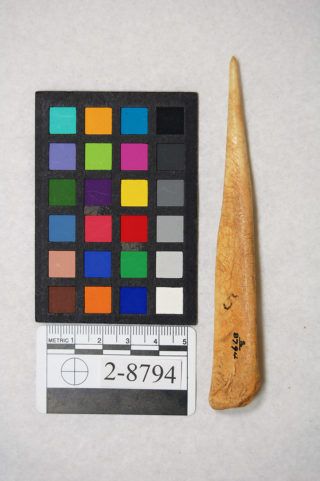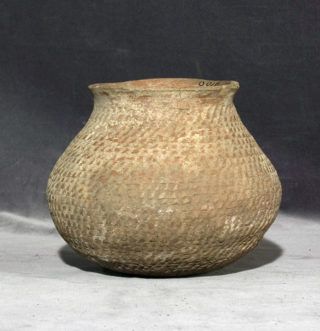The Arizona Collection by Joseph Peterson
On May 19, 1904, Joseph Peterson started to dig a trench through the West Berkeley mound, one of the oldest and largest prehistoric shell mounds in Central California. Paid with funding from Phoebe Hearst, he was following the steps of P. M. Jones, E. Furlong and Max Uhle to become one of the earliest field archaeologist to work on behalf of the recently established museum of anthropology. In addition to the excavation at the West Berkeley mound, he was dispatched to an handful of places in the San Francisco Bay area to salvage archaeological materials disturbed by building or road constructions. All these efforts resulted in over 250 catalog records.

Bone awl. Joseph Peterson, 1907
It was a busy spring semester, perhaps unexpectedly so, for a 27-year old schoolteacher from Snowflake, Arizona, who had arrived at UC Berkeley just a few months earlier to pursue a degree in Anthropology. Peterson ended up spending only one or two full semesters at Berkeley and by the fall of 1904, he and his family had gone back to Snowflake where his old job was waiting. Leaving Berkeley behind, however, did not sever his ties with archaeology and his academic mentor Alfred Kroeber. In January 1905, Peterson responded to a letter from Kroeber and a plan to begin an exploration of the many ancient ruins around Snowflake began to take shape:
In reply will say that I’ll furnish you the information required as soon as possible. I can give you a rough map of the ruins in this vicinity from memory. It will be useless to visit any of the ruins at present as snow covers the ground to a depth of about 6 inches with no prospects of disappearing for some time.
Kroeber also asked Peterson to gather information on the whereabouts of other expeditions in the area:
With respect to Dr. Palmer’s intentions I can give nothing definite as the last time I saw him I had not received your first letter. I may be able to glean some information from parties who were with him. I was unable to find any of them yesterday. […]. As far as intruding on his ground is concerned, I think there is sufficient material to avoid this, other than in a general way. Especially is this so if the leading idea or object in view differs. Shall need no funds until we can decide on plans.
Frank Palmer was a Californian antiquarian who, despite a lack of training, had been tasked by the Southwest Society (a branch of the American Institute of Archaeology) to organize an expedition in Arizona. The underlying scope of the project was to collect high-quality artifacts to be exhibited in a new public museum in Los Angeles. While arguably competing for the same treasures Kroeber had a more academic attitude about it. Palmer and other collectors of the time were amateurs, with no proper training in field methodology and, in his words, did little to “bring out points new to science”. For the latter to happen amateurs like Palmer should be replaced by trained archaeologists, like Peterson.

Ground decorated potsherd. Joseph Peterson 1907
Kroeber was very interested in the archaeological record of the southwestern United States, more so than he was about California archaeology. One of the reasons was that Ancient Pueblo people were farmers and had domesticated animals, they built permanent villages with large buildings that would indicate a level of social complexity that was not yet recognized for hunter-gatherers. Ancient Pueblo people also had a rich tradition of pottery making, and shapes and decorations could be used to distinguish different cultural traditions and to create chronological sequences. California Indians, with few exceptions, didn’t rely on domesticated species and while they used clay to create figurines, pipes and other objects, they did not make pottery. That was enough evidence to persuade Kroeber that the lifestyle of California Indians had remained substantially unchanged for thousands of years. He expressed this conviction by dismissing Uhle’s interpretation of culture change at Emeryville and, as Heizer recalled years later, effectively limiting archaeological research in Central California by channelling most of the department budget to ethnographic research. But with Peterson in Arizona, Kroeber saw an opportunity to directly acquire valuable archaeological collections for a relatively low cost and with far superior provenience information that those received by exchange with other institutions or those from Phoebe Hearst personal collections.

Corrugated jar. Joseph Peterson 1906
Kroeber had high expectations for the Arizona project but Peterson could only partially fit the image of a professional field archaeologist. This was not for lack of enthusiasm, however. Between 1906 and 1908, Peterson explored and collected objects from about 25 ruins that likely dated between the 9th and 11th century AD. His notes about provenience and the relationship between objects, features, rooms and burials are well written but ultimately lacking in details and it is unknown if he took any photos while at work. He knew, however, Kroeber’s appetite for all things that fit the image of prehistoric farmers and he didn’t fail to please his mentor as these clips about turkeys and corn nicely illustrate:
Turkey bones are found in the ruins lower down the river than this game ever comes at present day, and it is reasonable to assume that turkeys were domesticated. I have now on hand a few specimens including 15 or 20 crocks, as many stone specimens, and about 40 smaller articles. I have the complete skeleton of a turkey evidently buried with rites, and about 8 human skeletons.
I enclose under separate cover a stalk of wheat the history of it as reported to me as follows. A party in the Grand Caňon region found in a small vase a few shrunken kernels. How long they had been there is not known as the vase was taken from a ruin. The people who gave me the stalk stated that they received only five of those shrunken kernels from which after three years time they have produced their patch of a few square rods. As I had never seen wheat similar to the specimen I thought I would try at least to find out if it is a common form or if it is something new. The story of its retaining its fertility throughout centuries seems incredible yet the owners gave me the story as a fact.

Barley stalk. Joseph Peterson, 1907
The letters Peterson wrote to Kroeber tell the story of genuine anthropological fervor not supported by adequate resources and budget as his frequent concerns about shipping charges seem to indicate. The collection includes about 850 catalog records; a substantial number and yet it pales compared to the amount of material amassed by earlier and contemporary expeditions to the Southwest that are now scattered in many museums. The fast-paced spoiling of ancient ruins in many parts of the country led to the Antiquity Act of 1906, something that Peterson acknowledged in a letter as a cause for delays in his plan to explore certain ruins. He never received a permit to work on public land and the project came to an end in July 1908 with Peterson promising to send more maps and reports but the correspondence ends there.
Despite any shortcomings, the Peterson collection was a great achievement and it remains as a testimony of the early days of archaeology as an academic discipline; it was never published but it was exhibited multiple times over the decades. We know that Joseph Peterson traveled to California in 1934: perhaps he had a chance to see his objects in the museum’s old Southwest Hall in San Francisco.
